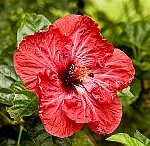Hibiscus for Hypertension
 We all know the negative health consequences from high blood pressure. High blood pressure, or hypertension, is referred to as the “silent killer” since often no physical symptoms appear while damage accumulates to organ systems eventually resulting in a health crisis. The red flowers of the Hibiscus tree offer promise to those looking for natural alternatives to prescription drugs used to treat hypertension. Hibiscus has been used for centuries as a folk medicine in the tropics for hypertension. In this post, I will discuss the use of Hibiscus to lower blood pressure.
We all know the negative health consequences from high blood pressure. High blood pressure, or hypertension, is referred to as the “silent killer” since often no physical symptoms appear while damage accumulates to organ systems eventually resulting in a health crisis. The red flowers of the Hibiscus tree offer promise to those looking for natural alternatives to prescription drugs used to treat hypertension. Hibiscus has been used for centuries as a folk medicine in the tropics for hypertension. In this post, I will discuss the use of Hibiscus to lower blood pressure.
What is the Scientific Evidence for Hibiscus in Lowering Blood Pressure?
The results are impressive with up to a 17 mm mg reduction in systolic blood pressure after 6 weeks of hibiscus tea consumption (Journal of Human Hypertension 2009; 23, 48-54).
One study found hibiscus extract to be more effective than the prescription drug Lisinopril in reducing blood pressure (Planta Med 2007; 73(1), 6-12 ).
These positive studies come from reputable research institutions and were published in scientific peer reviewed journals. One study was conducted at the USDA Nutrition Research Center on Aging at Tufts University, in Boston, Massachusetts.
Many claims for herbal supplements are based solely on studies either performed in a test tube or in a lab animal.
These studies were performed on humans using the gold standard of a double-blind test where neither the researchers nor the test subjects know who got a placebo and who got the real deal until the end of the experiment.
I find it particularly satisfying when folk wisdom is backed up by scientific evidence.
What is Hibiscus’s Active Compound?
The active principal in Hibiscus is a form of polyphenol. Yes, the same class of compounds found in green tea and red wine that we’ve all heard about, perhaps ad nauseum, through advertising and the media.
The polyphenols in Hibiscus are called sambubiosides.
Wow, that’s a mouthful!
How Much Do I Need to Take?
The beauty of the studies mentioned above is that it didn’t take superhuman quantities of the tea to see results. In some cases, as little as three cups per day of the pleasant tasting tea was effective in lowering blood pressure in 6 weeks. The tea was prepared simply by steeping one tea bag per cup of hot water.
Since this is a polyphenol, like those found in tea, the same rules for tea prep should be followed. The guidelines for maximizing tea polyphenols were discussed previously.
Loose hibiscus flowers can be purchased at health food stores and online as well as in tea bags. Celestial Seasonings Red Zinger Tea is a pleasant tasting tea that contains hibiscus.
Hibiscus flowers when steeped turn the water a crimson red and the taste is tart like cranberry juice. So you probably want to sweeten with your favorite sweetener. Add lemon and ginger for a little more zest. A refreshing ice tea can also be made from the flowers.
The other option is to take an standardized extract of Hibiscus in capsule form. Swanson Health Products makes an Hibiscus extract standardized for 50% total phenolics providing 5% sambubiosides in each 200 mg of extract per capsule. So this would equal 10 mg of sambubiosides per capsule (200 mg x 0.05 = 10 mg).
Suggested dose would be one capsule in the morning and one before bedtime.

No Comments